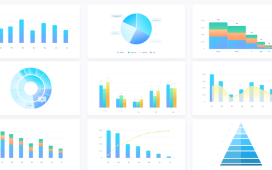Virtual events – that still sounds a bit futuristic. Such events have been around since 1993, when the world’s first live stream showed exciting webcam images of a coffee machine at work. The dripping coffee has been viewed several million times.
In some ways, this has not changed until 2020. On TikTok, teenagers create viral videos with snooze feeds that they use to earn crypto coins, literally in their sleep. Technical advances and ever-new social media options now offer us completely different possibilities of online contact, from virtual museum tours to live Q&A sessions with astronauts in space.
Even some of the biggest conferences today take place partly or completely digitally. This not only reduces costs and improves the carbon footprint – it also allows you to appeal to and invite a wider audience. Thanks to Coachella’s YouTube livestream, more than 41 million people in over 232 countries were able to experience the Beyoncé concert film Homecoming in 2018, instead of the few hundred thousand who attended the concerts in person.
Companies of all kinds now host virtual events online, from live twittering to live streaming. Is your company prepared for this digital world?
Whether you’ve already planned an event or are just looking for new ideas, this entry is the ultimate entry into the universe of virtual events.
What is a virtual event?
A virtual event is any kind of organized meeting that takes place online rather than in a physical location. This can range from small question-and-answer sessions to large conferences with thousands of participants. And apparently even the livestream feed of a mug pyramid can be a virtual event.
Below we give you an overview of the different online business events your company can host.
Instructions, tutorials and lessons
Do you work with products or services that require explanation? Then a guide is the appropriate way to support your target group with tips, tricks and instructions for use.
This type of event can be used to launch a new product, answer frequently asked questions, or introduce various use cases. With a full-fledged module, you deliver even greater value. As a yoga instructor, you could show a few exercises online, as a chef presenting a cooking class online.
Training and courses
Webinars, workshops and courses are generally better suited for more complex topics. These formats can provide deep insights into specific topics, skills, tools, and more. Hootsuite Deutschland offers webinars on topics such as LinkedIn for companies or Storifying Social – digital storytelling.
Guided tours behind the scenes
Let your followers take a look behind the scenes. Museums, galleries, theatres, airports and even national parks can show online visitors what to expect when visiting – or what everyday life looks like for the employees of the respective attraction.
That’s why your company doesn’t have to be an attraction. Offer guided tours of your laboratory, factory, office, workshop, trade fair or test kitchen. Demonstrate to customers what is behind their favorite products.
Interviews and performances
Ask in-house professionals to share their knowledge live in Q&A sessions. Host relaxed question-me-everything rounds on social media. Invite speakers or artists to talk for you about a topic or to present your art.
The possible spectrum ranges from TED talks to comedy shows to very personal interviews. Interactive quiz games and competitions also increase engagement.
Conferences and events
Even large events can be partly virtual. From Coachella to SXSW, concerts and summits have already been streamed online so that people who do not attend in person can still get into the action. However, there are also entire conferences that take place exclusively online and even offer their participants networking opportunities and meetings in smaller circles.
And with these tools, you’re hosting a virtual event
There are a variety of ways to host a virtual event. We present a summary of the different formats and some of the best platforms for virtual events.
Live Twittering
Start an online discussion by tweeting an event live, asking a question, or even hosting A Question Time. Use a hashtag so that people can find the discussion and get into it.
Other online discussion tools include:
- Discord: free voice and text chat, mainly used by gamers
- Reddit: a discussion forum especially popular for question-me-everything-sessions (AMA = Ask Me Anything)
- Slack: an instant messaging platform where chats can be organized well
Social Media Stories
Stories are a wonderful platform for sharing videos and images for tutorials, interviews and the like. Add filters, special effects, and stickers to answer questions, conduct surveys, host an influencer takeover, and so on. On Instagram, you can create a highlight for later viewers. These types of promotions work especially well for visually energetic businesses such as those involved in the arts or creative gifts space.
For short-lived live events:
- Instagram Stories
- Facebook Stories
- TikTok
- Snapchat
Webinars
Normally, a webinar is an online presentation that is held in real time, but can also be shared and viewed later. In most cases, the speaker shows his screen, which shows slides and demos as he talks about it. Participants can ask questions via voice or via a chat feed (depending on what the presenter is saying and what is possible on the platform).
In principle, the event is something of a one-time workshop or a real-time lesson.
Webinar platforms include:
- 6connex: available for any browser and all devices without download. Features include flexible registration, social media integration, and real-time analytics.
- Crowdcast: Participants can enter via a uniform URL. Tools available include built-in registration forms, analytics, repetitive playback, and more.
- Demio: enables pre-recorded or live webinars – or a mix of both. Included are private chats, interactive surveys, call-to-action buttons and other features.
- Livestorm: Livestorm on-demand webinars offer integration with Google Analytics, Slack and various interaction tools.
- WebinarNinja: There is no software to download for this platform, which offers free and paid events. Also in the program: integration with more than 1,000 apps and ad tracking with Facebook Pixel.
- Zoom: Platform for a single moderator or group chat – there are even breakout rooms. Events are offered for 100 to 10,000 participants who can only watch.
YouTube Livestream: free and easy-to-use platform for streaming live webinars.
Social media livestreams
Virtually all social media platforms offer a live video feature. Livestreams are known to lead to more engagement. According to Facebook, a live video averages six times as many interactions as a normal video.
Social media livestream platforms include:
- Instagram Live
- Facebook Live
- LinkedIn Live
- TikTok
- Twitter Live
- YouTube Livestream
Most live streams display comments and participants in real time. Some platforms, such as Instagram, allow you to go live with a friend at the same time. This option is very suitable for Q&A sessions and joint presentations.
Facebook is expected to soon offer live sales features.
Conferences and Networking
For more formal virtual events, platforms are available that offer tool suites with live streaming, chat rooms, and other features.
- 6connex: Exhibitors can use this virtual trade platform to create online booths to compete, livestream and chat for leaderboard positions.
- AirMeet: is a comprehensive platform for community managers who want to host engaging online events
- Brella: The virtual conference hub is suitable for presenters, multitrack agendas, sponsors, individual streams and more.
- HeySummit: Create a landing page, introduce speakers, register attendees, and so on. This solution helps you organize virtual events, but you still need to integrate live streaming tools.
- Hop In: The comprehensive platform for live events covers everything from networking events to meetings, trade fairs and webinars to live broadcasts.
- Run the World: Conference platform for cocktail parties to fireplace talks. Integrated templates for different use cases minimize the effort of event planning.
- Vfairs: The virtual trade fair platform offers booths, webinars, conversation-entry tools and much more.
Tips for organizing virtual events
Each event has its own logistical requirements. This way you avoid problems during your virtual event.
1. Work out a strategy
For every event, whether small or large, offline or online, you should have a strategy in petto. Start with your most important goal and a basic concept, and continue to work on this basis. The sooner you make a plan, the better.
Before hosting a virtual event, you should answer the following questions:
- What kind of experience do you want to convey?
- Should the event be live, on-demand or both?
- Where do you want to see the content?
- Will access be restricted or unlimited?
- When is the best time for the event?
- Do I have to register for the event?
- How will you promote the event?
- Are you planning a cooperation with an advertising medium or another partner?
- Is it possible to watch the event when it is over?
- What KPIs and other data do you want to track?
2. Choose the right time
Regardless of size or platform, choosing the right date and time is critical to your event. Do some research before announcing the appointment to your network. Make sure there are no competing events or holidays that could prevent your target audience from participating.
Also consider the time zones. If you want to host your event worldwide, you should choose a time that suits as many of your customers and followers as possible. If that doesn’t work, make sure that the content is still accessible to those who couldn’t be there directly after the live presentation. It may also be worth planning multiple networking events and different virtual events for different time zones.
Find out in your Analytics when your community is usually online. If you want to reach the broadest possible consensus, consider sending a survey or online where participants can choose their preferred dates. Emily Schuman, the founder of Cupcakes & Cashmere, used an Instagram Story sticker to set the start time and duration of an Instagram live session.
3. Promote your event
“Make the event, then the audience comes by itself” is clearly a fallacy. “Host the event, then people will come” is correct – especially if you offer useful incentives.
Determine which arguments are most likely to convince potential participants in your event. This could be an outstanding speaker, but so could the transfer of skills, a networking opportunity, etc.
No matter what you choose, it should be communicated clearly and unambiguously as a performance promise in your marketing.
Share details of your events via email and social media. When you run ads, address your audiences and choose the right format. For example, LinkedIn’s InMail ads might be better suited to such invitations than impersonal sponsored posts.
According to Adobe, most registrations come in two to three weeks before the scheduled event. During this time, you should ramp up your activities.
Use the available social media tools. Start an event countdown in Instagram Stories. Create a Facebook event with all the information you need. Consider announcing your event on sites like Eventbrite and other locations that your audience is frequented.
Presenters are often also influencers – so provide them with all the important information so that they can become ambassadors for your event. Never forget the four Ws: who, what, where and how? This also means that any marketing activity for your event should include a link. This will show your target group the way – whether to the registration form or to your Instagram profile.
Be sure to share an event hashtag. So that others can promote your event and discuss it online.
4. Be prepared for technical problems
There may be breakdowns in physical events – and technical glitches at virtual events.
Before you get started, you should test your Internet connection and also ask your speakers to do so. Prepare backups of images and presentation in case a file suddenly becomes unusable or disappears. If possible, perform a sample. The sooner you detect a problem, the faster you can find solutions.
Remember that not all of your guests are tech experts. So avoid potential difficulties by preparing easy-to-understand instructions or FAQs. If you have sufficient resources for technical support, use them—and make sure that students know where to find that support and how to ask for assistance.
5. Plan an inclusive event
Like events with “real” participants, virtual events should be as inclusive and accessible as possible.
Ensure that all points of contact, including presentations, use clear language, large fonts, and high color contrast. If possible, offer subtitles and images for the sound as well as descriptions for the visual part. Websites such as Vfairs also offer the possibility to have page content read aloud and to adjust font sizes yourself.
And although this should now be taken for granted: If there is a group of experts in your event, do not choose only white cisgender men. Otherwise, your event might become a social media trend for the wrong reasons… So make sure that your virtual event presents as much variety as possible.
6. Promote engagement
It’s simple: if you offer engagement opportunities, your audience will interact more. This is because it is fun to see the result of the engagement.
A simple example: Ask viewers to ask questions in comments or through a chat tool. Most likely, the people who have asked questions will stay at the event to see if their questions are answered. Professional tip: If you choose to do so, it is important to use a moderator who can give an answer.
Virtually every online platform has interactive features. Invite event participants to participate in surveys or quiz games. Encourage live tweeting. Accept requests and suggestions. Or just mention the names of the people who tune in to your event. At the end of the event, you should ask for feedback.





